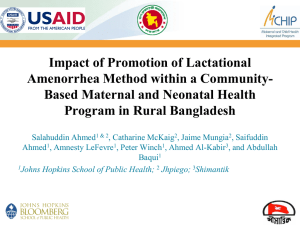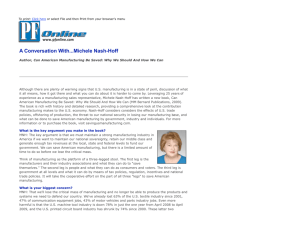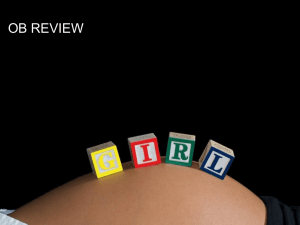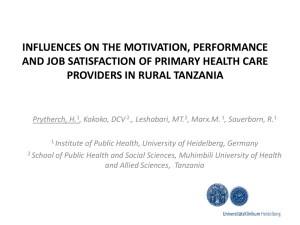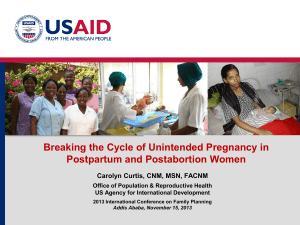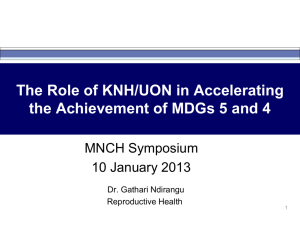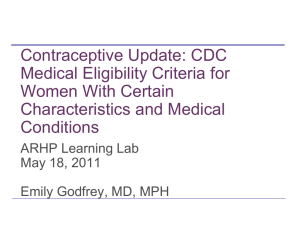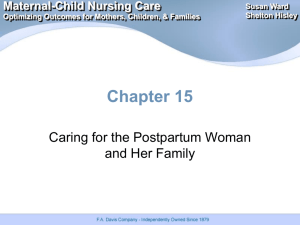Impact of Integrating Family Planning within a Community
advertisement
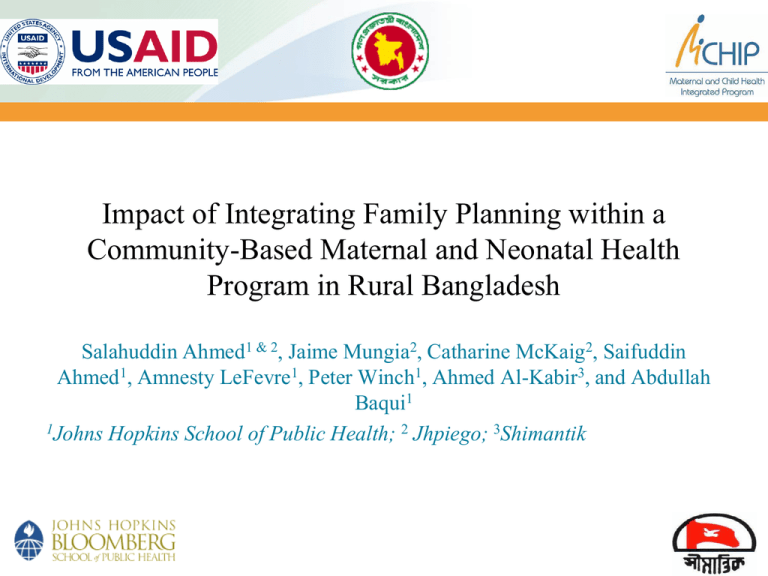
Impact of Integrating Family Planning within a Community-Based Maternal and Neonatal Health Program in Rural Bangladesh Salahuddin Ahmed1 & 2, Jaime Mungia2, Catharine McKaig2, Saifuddin Ahmed1, Amnesty LeFevre1, Peter Winch1, Ahmed Al-Kabir3, and Abdullah Baqui1 1Johns Hopkins School of Public Health; 2 Jhpiego; 3Shimantik 1 Study Context Selected FP indicators in Sylhet, BDHS 2007 TFR by Divisions, Bangladesh, 2004 2.6 2.9 4.2 Indicators Sylhet Unmet FP need 26% CPR (any method) 31% TFR 3.7 Birth intervals 2.8 2.9 3.7 <24 months 26% <36 months 57% Integrated model of PPFP & MNH Evolution of MNCH packages Designed a community-based maternal and newborn care intervention package and evaluated the effectiveness of the package using a cluster randomized design A home care package which involved CHW antenatal and postnatal home visits and management of sick newborn reduced NMR by 34% (Baqui et al., Lancet, 2008) Newborn care 3 Postpartum FP counseling and contraceptive distribution Study Objectives 1. To develop and test an integrated Family Planning, Maternal and Neonatal Health (FP/MNH) service delivery approach 2. To assess the strengths and limitations of integrating FP into an ongoing community-based MNH care program 3. To assess the impact of the intervention package on contraceptive knowledge and practices including LAM during the extended postpartum period 4. To assess the impact of the intervention package on pregnancy spacing 4 Study Design Study sites: eight unions in two sub-districts in Sylhet district, Bangladesh Non-Random Allocation Comparison unions: four Enrolled women: 2257 Intervention unions: four Enrolled women: 2247 Enrollment of women during <8 months of pregnancy Comparison clusters: MNH ONLY during ANC and Postpartum visit Intervention clusters: MNH plus FP during ANC and Postpartum visit Follow the cohort through pregnancy to 36 months postpartum 5 Intervention Delivery Strategy Service Delivery: Home visits by CHWs Conduct pregnancy surveillance and provide contraceptives • Conduct visits to all households every two months to identify new MWRA and pregnant women • • Pills, condoms, and follow up doses of injectables Refer for other methods Counsel in antenatal and postpartum periods • Messages on LAM and transition, return to fertility, healthy spacing, contraceptive methods Community mobilization: Conduct meetings with husbands, mothers-in-law and community leaders to raise awareness 6 about PPFP messages Results 7 Starts in a Low Performance Area Ever Used Contraceptive Method Intervention 18.0 Control 21.1 0 10 20 30 40 50 Percent 60 70 80 90 100 Contraceptive Use Rate at 3, 6, 12, and 18 Months Postpartum by Study Arm 50% 47% 45% 40% 42% 36% 37% 34% 35% 30% 27% 25% 18% 20% 15% 11% 10% 5% 0% 3 months 6 months 12 months 18 months 3 months 6 months 12 months 18 months Intervention Comparison 9 Contraceptive Use Rate at 3, 6, 12, and 18 Months Postpartum by Study Arm 50% 45% 47% 42% 40% 37% 36% 34% • Statistically significant improvement in the contraceptive use rate in the intervention area 35% during the high risk period of first 18 months after delivery 30% 27% -- 18% ever user before the index pregnancy to 47% at 18 months postpartum 25% -- 21% ever user before the index pregnancy to 34% at 18 months postpartum 18% 20% • High number of new users and a trend towards increased early adoption 15% 11% 10% 5% 0% 3 months 6 months 12 months 18 months 3 months 6 months 12 months 18 months Intervention Comparison 10 Probability of Contraceptive Adoption by Study Arm 1.00 Contraceptive adoption during PP period 0.00 0.25 0.50 0.75 P<.001 1 2 3 4 5 6 7 8 9 10 11 12 13 14 15 16 17 18 Months since delivery Intervention 11 Control Probabilities of Pregnancy Incidence during 18 months of postpartum follow-up period 0.00 0.05 0.10 0.15 Self Reported Pregnancy Incidence 1 2 3 4 5 6 7 8 9 10 11 12 13 14 15 16 17 18 Months since delivery Intervention Control The difference is statistically significant (P = 0.03) 12 Does integration of FP adversely affect MNH program? 13 CHW Home Visit Coverage Pregnancy counseling- 1 Pregnancy counseling- 2* Newborn-1 counseling Newborn-3 counseling Newborn-6 counseling* Newborn-9 counseling Newborn-15 counseling Intervention Comparison (n=1889) (n=1838) 92% 86% 74% 72% 73% 73% 51% 97% 90% 80% 76% 75% 77% 50% 14 *Integrated counseling Effect of Integration on MNH Care: Selected Newborn Care practices by Study Arm Drying and wrapping of newborn within 10 minutes of delivery Initiation of Breastfeeding within 30 minutes Intervention (%) 50.4 Comparison (%) 56.6 46.8 44.1 15 Duration of exclusive breastfeeding by study arm 0.00 0.25 0.50 0.75 1.00 Duration of Exclusive Breastfeeding by Study Arm 1 3 analysis time Intervention 16 6 Control Lessons Learned HFS demonstrates 1. The feasibility of integration of FP within a community-based MNH program. 2. The effectiveness of the model in increasing modern method use. 3. No notable negative effect on the delivery of MNH services. 4. The promotion of LAM had a positive effect on the duration of exclusive breastfeeding. 17 Study Partners Funded by USAID Shimantik and CDPA Government of Bangladesh JHSPH ACCESS-FP /MCHIP 18 THANK YOU 19

